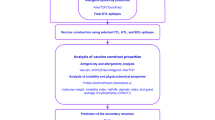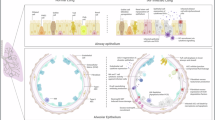Abstract
While searching for alternative reading-frame peptides encoded by influenza A virus that are recognized by CD8+ T cells, we found an abundant immunogenic peptide encoded by the +1 reading frame of PB1. This peptide derives from a novel conserved 87-residue protein, PB1-F2, which has several unusual features compared with other influenza gene products in addition to its mode of translation. These include its absence from some animal (particularly swine) influenza virus isolates, variable expression in individual infected cells, rapid proteasome-dependent degradation and mitochondrial localization. Exposure of cells to a synthetic version of PB1-F2 induces apoptosis, and influenza viruses with targeted mutations that interfere with PB1-F2 expression induce less extensive apoptosis in human monocytic cells than those with intact PB1-F2. We propose that PB1-F2 functions to kill host immune cells responding to influenza virus infection.
This is a preview of subscription content, access via your institution
Access options
Subscribe to this journal
Receive 12 print issues and online access
$259.00 per year
only $21.58 per issue
Buy this article
- Purchase on SpringerLink
- Instant access to full article PDF
Prices may be subject to local taxes which are calculated during checkout






Similar content being viewed by others
References
Webster, R.G. Influenza virus: transmission between species and relevance to emergence of the next human pandemic. Arch. Virol. Suppl. 13, 105–113 (1997).
Lamb, R.A. The influenza virus RNA segments and their encoded proteins. in Genetics of Influenza Viruses (eds. Palese, P. & Kingsbury, D. W.) 26–69 (Springer, New York, 1983).
Mayrand, S.M. & Green, W.R. Non-traditionally derived CTL epitopes: exceptions that prove the rules? Immunol. Today 19, 551–556 (1998).
Vitiello, A. et al. Immunodominance analysis of CTL responses to influenza PR8 virus reveals two new dominant and subdominant Kb-restricted epitopes. J. Immunol. 157, 5555–5562 (1996).
Rötzschke, O. et al. Isolation and analysis of naturally processed viral peptides as recognized by cytotoxic T cells. Nature 348, 252–254 (1990).
Kozak, M. Structural features in eukaryotic mRNAs that modulate the initiation of translation. J. Biol. Chem. 266, 19867–19870 (1991).
Williams, M.A. & Lamb, R.A. Effect of mutations and deletions in a bicistronic mRNA on the synthesis of influenza B virus NB and NA glycoproteins. J. Virol. 63, 28–35 (1989).
Pleschka, S. et al. A plasmid-based reverse genetics system for influenza A virus. J. Virol. 70, 4188–4192 (1996).
Becerra, S.P., Koczot, F., Fabisch, P. & Rose, J.A. Synthesis of adeno-associated virus structural proteins requires both alternative mRNA splicing and alternative initiations from a single transcript. J. Virol. 62, 2745–2754 (1988).
Fenteany, G. et al. Inhibition of proteasome activities and subunit-specific amino-terminal threonine modification by lactacystin. Science 268, 726–731 (1995).
Laemmli, U.K. Cleavage of structural proteins during the assembly of the head of bacteriophage T4. Nature 227, 680–685 (1970).
Waterhouse, N.J. et al. Cytochrome c maintains mitochondrial transmembrane potential and ATP generation after outer mitochondrial membrane permeabilization during the apoptotic process. J. Cell Biol. 153, 319–328 (2001).
Schultz-Cherry, S., Krug, R.M. & Hinshaw, V.S. Induction of apoptosis by influenza virus. Semin. Virol. 8, 491–495 (1998).
Schultz-Cherry, S., Dybdahl-Sissoko, N., Neumann, G., Kawaoka, Y. & Hinshaw, V.S. Influenza virus ns1 protein induces apoptosis in cultured cells. J.Virol. 75, 7875–7881 (2001).
Ferri, K.F., Jacotot, E., Blanco, J., Este, J.A. & Kroemer, G. Mitochondrial control of cell death induced by HIV-1–encoded proteins. Ann. N.Y. Acad. Sci. 926, 149–164 (2000).
Kneller, D.G., Cohen, F.E. & Langridge, R. Improvements in protein secondary structure prediction by an enhanced neural network. J. Mol. Biol. 214, 171–182 (1990).
Mandelboim, O. et al. Recognition of haemagglutinins on virus-infected cells by NKp46 activates lysis by human NK cells. Nature 409, 1055–1060 (2001).
Kawaoka, Y., Krauss, S. & Webster, R.G. Avian-to-human transmission of the PB1 gene of influenza A viruses in the 1957 and 1968 pandemics. J. Virol. 63, 4603–4608 (1989).
Van Campen, H., Easterday, B.C. & Hinshaw, V.S. Destruction of lymphocytes by a virulent avian influenza A virus. J. Gen. Virol. 70 (Pt 2), 467–472 (1989).
Taubenberger, J.K., Reid, A.H. & Fanning, T.G. The 1918 influenza virus: a killer comes into view. Virology 274, 241–245 (2000).
Chakrabarti, S., Brechling, K., & Moss, B. Vaccinia virus expression vector: coexpression of β-galactosidase provides visual screening of recombinant virus plaques. Mol. Cell Biol. 5, 3403–3409 (1985).
Garcia-Sastre, A. et al. Influenza A virus lacking the NS1 gene replicates in interferon-deficient systems. Virology 252, 324–330 (1998).
Liou, W., Geuze, H.J. & Slot, J.W. Improving structural integrity of cryosections for immunogold labeling. Histochem. Cell Biol. 106, 41–58 (1996).
Chen, W., Anton, L.C., Bennink, J.R. & Yewdell, J.W. Dissecting the multifactorial causes of immunodominance in class I–restricted T cell responses to viruses. Immunity. 12, 83–93 (2000).
Chen, W., Yewdell, J.W., Levine, R.L. & Bennink, J.R. Modification of cysteine residues in vitro and in vivo affects the immunogenicity and antigenicity of major histocompatibility complex class I–restricted viral determinants. J. Exp. Med. 189, 1757–1764 (1999).
Acknowledgements
We thank B. Buschling for technical assistance; A. Weisberg for cryo-electron microscopy; K. Bruns for secondary structure predictions using NNPREDICT; D. Green for generously and expeditiously providing cytochrome c–transfected cells and unpublished data; and D. Tscharke for critical comments on the manuscript and assistance with the graphics.
Author information
Authors and Affiliations
Corresponding author
Rights and permissions
About this article
Cite this article
Chen, W., Calvo, P., Malide, D. et al. A novel influenza A virus mitochondrial protein that induces cell death. Nat Med 7, 1306–1312 (2001). https://doi.org/10.1038/nm1201-1306
Received:
Accepted:
Issue date:
DOI: https://doi.org/10.1038/nm1201-1306
This article is cited by
-
The role of PB1-F2 in adaptation of high pathogenicity avian influenza virus H7N7 in chickens
Veterinary Research (2024)
-
Influenza viral matrix 1 protein aggravates viral pathogenicity by inducing TLR4-mediated reactive oxygen species production and apoptotic cell death
Cell Death & Disease (2023)
-
Human sorting nexin 2 protein interacts with Influenza A virus PA protein and has a negative regulatory effect on the virus replication
Molecular Biology Reports (2022)
-
Innate immune responses at the asymptomatic stage of influenza A viral infections of Streptococcus pneumoniae colonized and non-colonized mice
Scientific Reports (2021)
-
Unconventional viral gene expression mechanisms as therapeutic targets
Nature (2021)



